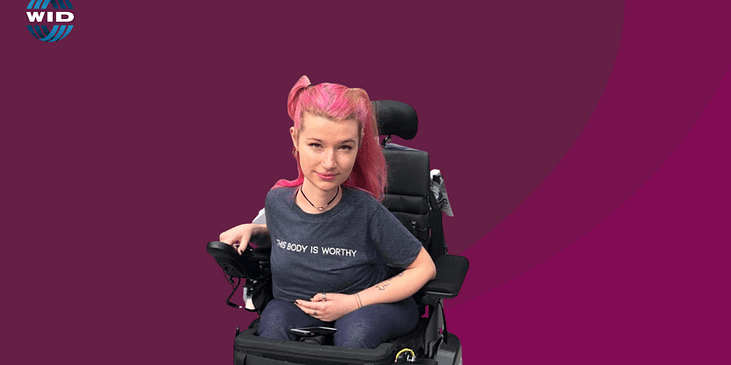By Hannah Soyer
Winter storms mean limited mobility for everyone––they often serve as reminders that we are powerless to the elements and that our plans to venture out into the world may need to be put on hold. No one, really, is immune to this. But for people with disabilities, including elderly individuals, winter storms bring higher stakes.
As a person born and raised in Iowa, I am used to harsh winters and lots of snow. It has never phased me, despite hating the cold––winter is always something I simply hunker down for. However, it was not until my freshman year of college at the University of Iowa that I became aware of the added accessibility barriers this particular season brings.
I did not have my wheelchair-accessible van with me that first year of college, and because it did not always work timewise to take the campus bus, I walked to a good amount of my classes. After snow, the plows would clear the streets, pushing the snow into the curb cuts of sidewalks. This made them anywhere from difficult to impossible to traverse, meaning I would either have to find an alternative route or get stuck and hope that my helper could dislodge me and my 377-pound chair.
This––and other accessibility woes––are common for people with disabilities across the lifespan.
Disabled Iowan Tucker Cassidy, who is a friend of mine, lived in United States Department of Housing and Urban Development (HUD) housing specifically designed for people with disabilities for 12 years after finishing college. Although the apartment complex was managed by the city, it would sometimes take days for the city to clear its snow. This had real-life implications for Cassidy: One winter, his wheelchair-accessible van (which sits much lower to the ground, as most adapted vehicles do) got stuck in the snow on the driveway, which had not been cleared. He ended up being stuck in his apartment for 3-4 days before a plow came to start clearing the snow. He ended up getting to his family Christmas a day or two late, not because roads were too icy for anyone to drive, but because his apartment’s driveway had not been plowed.
Despite numerous phone calls, the problem of poor snow removal persisted after this incident. “My neighbors, all disabled as well, were often tasked with clearing off the sidewalks in order for a couple of us to even get out of our apartments,” he said. And another year? He actually did miss his family Christmas, because that same apartment’s driveway wasn’t cleared of snow.
Winter accessibility woes are not just a problem in Iowa. Most cities across the country, even those that claim they are pedestrian-friendly, prioritize roads over sidewalks when it comes to snow removal. And although many cities have ordinances in place to ensure private sidewalks are cleared, this simply is not as effective as it needs to be. Some disabled individuals may have a harder time clearing their sidewalks than others if they are able to at all.
Believe it or not, proper snow removal is a legal issue. Under the Fair Housing Act in the United States, people with disabilities must be able to access the place they live in the same way non-disabled people do, which means an accessible entrance cannot be hidden, hard to get to, or out of the way. But when a pile-up of snow means some pathways to apartment buildings are not cleared adequately, this legally required access is in peril. While this specific instance doesn’t apply to a house you own, it covers nearly every other housing out there. This means that Cassidy and his neighbors being unable to exit and enter their apartments was a violation of the law.
It’s important that we realize winter inaccessibility is more than just snow as a physical barrier––icy terrain can also make it more difficult for people with all sorts of mobility impairments to move around. In addition, people who are blind or visually impaired may have difficulties differentiating icy patches from safer paths. If it’s cold enough for pipes to freeze or power lines to go out, disabled people who rely on specific electrical equipment or temperature-controlled medications are suddenly without necessary supports. The danger of these situations is compounded by a lack of accessible transportation, meaning many disabled people cannot simply hop in their friend’s car to head somewhere safer. This can, quite literally, be a matter of life and death––as reported by the Houston Chronicle, at least 20 people who died during the Texas freeze of February 2021 had serious medical conditions and needed the power to keep them alive and healthy.
As climate change progresses, the weather will become less predictable and more severe. And severe weather will not only impact disabled and chronically ill individuals disproportionately, it will also cause disabilitiesProlonged exposure to low temperatures can lead to severe health consequences, exacerbating existing disabilities and creating new ones, with temporary or permanent damage due to cold injuries and freezing injuries. With over 40% of the homeless population in the United States identifying as disabled, the accessibility of public spaces, shelters, and affordable housing becomes even more important. Forgetting about disability in relation to winter storms has never been an option, and it certainly isn’t now.
How to help: as a state or local government
- Implement more proactive snow removal policies which do not place the responsibility on good samaritan neighbors
- Have plans in place to ensure curb cuts are cleared of snow and ice after streets are plowed
- Design winter storm response plans with people with disabilities, including the elderly, in mind. Better yet, hire people with multiple different impairments as consultants or project leads on these policies to make sure policies are designed for their needs. In line with the concept of Universal Design, cities will be safe and more accessible for everyone when the needs of those most impacted are brought to the forefront
- Like winter storm response plans, any disaster/emergency response plans must be designed with disabled people prioritized
How to help: as a non-disabled individual
- Check in on people with disabilities across the lifespan before and after winter storms––if a winter storm is predicted, ask them if they have snow removal lined up or need assistance with anything else, such as getting groceries or prescriptions picked up before the storm
- Amplify activism and requests from disabled members of your community: while one person calling the city about unplowed curb cuts might make a small difference, it becomes harder to ignore when larger numbers of people start calling, too
- Support the development of accessible, affordable, and well-maintained housing options to ensure that everyone has a safe place to take shelter
Published: February 25, 2022

Hannah Soyer is a Freelance Writer for WID.


0 comments on “Winter Accessibility Woes”